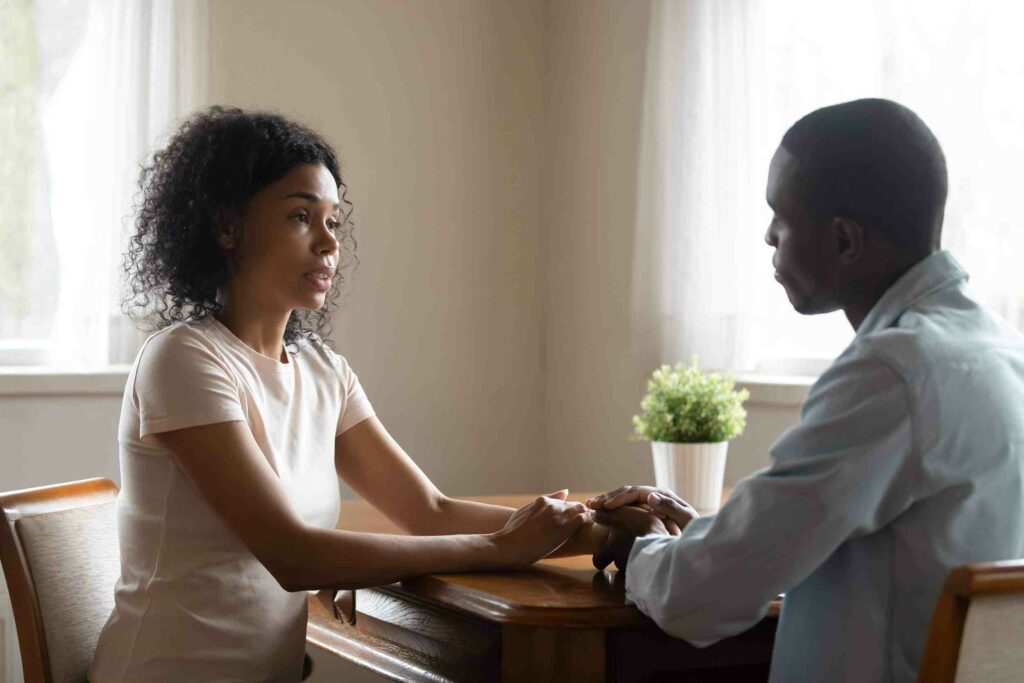There comes a time in many relationships when partners may find it difficult to communicate effectively, resolve conflicts, or deeply understand each other’s needs. During these moments, seeking professional help can become not just a wise decision, but also a necessary step toward restoring harmony and building stronger bonds. One of the most effective approaches in this regard is conjoint couples therapy. This therapeutic technique addresses relationship issues by involving both partners in the therapy sessions. And, helping them to unravel the knots of misunderstanding and rekindle the flames of love and understanding.
Contents
What Is Conjoint Couples Therapy?
 Conjoint Couples Therapy, often simply referred to as Couples Therapy or Marriage Therapy. It is a type of psychotherapy designed to help couples improve their relationships. The term ‘conjoint’ implies the simultaneous treatment of both individuals in the relationship, acknowledging that relationship issues typically involve dynamics between both partners.
Conjoint Couples Therapy, often simply referred to as Couples Therapy or Marriage Therapy. It is a type of psychotherapy designed to help couples improve their relationships. The term ‘conjoint’ implies the simultaneous treatment of both individuals in the relationship, acknowledging that relationship issues typically involve dynamics between both partners.
In conjoint couples therapy, both partners actively participate in the therapy sessions with a therapist trained in relationship dynamics and conflict resolution. The therapy can cover a wide array of issues such as communication problems, sexual dissatisfaction, conflicts about child rearing or blended families, substance abuse, financial stress, infidelity, and more.
One of the fundamental principles of conjoint couples therapy is that the relationship itself is the “client”, rather than the two individuals. This approach recognizes that it’s the patterns of interaction between partners that need to be addressed, rather than attributing the cause of issues to one person or the other.
How Does Conjoint Couples Therapy Work?
Well, this therapy works by facilitating a safe and constructive environment where both partners can express their feelings, perceptions, and expectations. The process, although tailored to each couple’s unique situation, generally follows a specific structure:
Assessment Phase
During initial sessions, the therapist usually conducts a thorough assessment. This may involve individual interviews with each partner as well as joint sessions. The therapist gathers information about the relationship history, the presenting issues, each partner’s perspective on the problem, and their individual backgrounds. This helps in identifying dysfunctional patterns and understanding the dynamics at play.
Treatment Phase
Once the assessment is complete, the therapist shares feedback and works with the couple to set goals for therapy. The subsequent sessions focus on achieving these goals by addressing the identified issues.
A few common elements involved in the treatment phase are:
- Improving Communication: This is a fundamental part of conjoint couples therapy. The therapist helps partners learn how to express their needs, thoughts, and feelings more effectively and to listen more carefully to each other.
- Changing Behavior and Interaction Patterns: Therapists also work on helping couples change their negative interaction patterns. They might encourage partners to treat each other in more positive, nurturing ways, or they may guide partners in managing their conflicts and disagreements more constructively.
- Problem-solving: The therapist guides the couple in developing strategies to address specific issues, such as parenting disagreements, financial stress, or sexual dissatisfaction. This might involve teaching negotiation skills or promoting greater understanding of each partner’s position.
- Emotional and Psychodynamic Understanding: Sometimes, the therapy process may involve understanding unresolved issues from each partner’s family-of-origin that are being played out in the relationship. The couple might be encouraged to explore their emotional reactions and the unconscious patterns that underlie their conflicts.
Termination Phase
 Once the couple has made significant progress and met their treatment goals, therapy may start to wind down. In this phase, the therapist assists the couple in recognizing and consolidating their gains. They might also discuss potential future challenges and plan strategies to deal with them.
Once the couple has made significant progress and met their treatment goals, therapy may start to wind down. In this phase, the therapist assists the couple in recognizing and consolidating their gains. They might also discuss potential future challenges and plan strategies to deal with them.
Throughout the process, the therapist’s role is not to take sides or to decide who is right or wrong. In fact, they facilitate constructive communication and promote understanding. That ultimately, help the couple develop healthier ways of relating to each other.
What Techniques Are Used In This Therapy?
Here are some commonly used techniques:
- Active Listening: The therapist guides the couple to listen carefully and attentively to their partner’s point of view. And this is to be done without interrupting or preparing a rebuttal. This practice fosters empathy and understanding.
- ‘I’ Statements: Rather than blaming or criticizing the other person, the therapist encourages the couple to express their feelings. And needs from a personal perspective. For example, instead of saying, “You never help with the chores,” a partner might say, “I feel overwhelmed when I have to handle all the chores by myself.”
- Reflective Statements: This technique involves repeating or paraphrasing what a partner has said to ensure that the listener has accurately understood their point of view. It helps to validate the partner’s feelings and prevents misunderstandings.
- Reframing: The therapist helps the couple to view their problems and conflicts from a different perspective. This can often shed new light on the issue and open up potential solutions that had not been previously considered.
- Behavioral Interventions: The therapist may suggest specific behaviors or actions the couple can implement to address certain issues or improve their relationship. This could include things like planning regular date nights, dividing household chores fairly, or establishing a routine for discussing finances.
- Emotionally Focused Techniques: In some approaches, such as Emotionally Focused Therapy (EFT), the therapist guides the partners to express and explore their emotional responses in a safe environment. This can help them understand and reshape their emotional responses. That leads to more secure attachment and improved relationship satisfaction.
How To Make The Most Of Conjoint Couples Therapy?
 To make the most out of conjoint couples therapy, both partners need to be actively engaged and committed to the process. Here are some tips that can help maximize the benefits:
To make the most out of conjoint couples therapy, both partners need to be actively engaged and committed to the process. Here are some tips that can help maximize the benefits:
- Be Open and Honest
Communication is a vital part of therapy. It’s important to be open and honest about your feelings, concerns, and expectations. The more open you are, the better your therapist will be able to understand and assist you.
- Have Realistic Expectations
Therapy is a process that takes time and effort. Don’t expect immediate fixes or dramatic transformations after just a few sessions. Progress may be slow and subtle, but consistent effort can bring about significant change over time.
- Apply What You Learn
Therapy sessions are often filled with insights, tools, and techniques. But these are of little value unless applied outside the therapy room. Make sure to practice what you learn, take on ‘homework’ tasks seriously. And integrate your new skills into your everyday interactions.
- Be Patient with Your Partner
Just as you are working through your own feelings and challenges, so is your partner. It’s important to be patient with each other, offer support, and remember that change doesn’t happen overnight.
- Communicate with Your Therapist
If you feel that a certain approach isn’t working or if you’re uncomfortable with any aspect of the therapy, communicate this to your therapist. They can adjust their methods or address your concerns to ensure the process is as effective and comfortable as possible for you.
Remember, the goal of conjoint couples therapy is to improve the quality of your relationship. While the process may sometimes be challenging, the rewards can be significant.
How To Find The Right Therapist Near Me?
 Finding the right therapist is a crucial part of the therapeutic journey. Below are some steps to help you find a suitable conjoint couples therapist near you:
Finding the right therapist is a crucial part of the therapeutic journey. Below are some steps to help you find a suitable conjoint couples therapist near you:
- Referrals and Recommendations: Start by asking for referrals from trusted sources. Such as your primary care doctor, friends, family, or other healthcare professionals. If they’ve had a good experience with a therapist, they may be able to provide a reliable recommendation.
- Insurance Providers: Check with your insurance company for a list of in-network providers. This can help ensure that the therapy is covered by your insurance plan and is financially feasible for you.
- Online Search: Simply doing an online search for “conjoint couples therapist near me” or similar terms can yield many results. Be sure to verify the credentials and read reviews or testimonials if available.
After you have a list of potential therapists, consider the following factors:
- Experience and Specialization: Ensure the therapist has experience and training in conjoint couples therapy. You might also want a professional who specializes in issues specific to your situation.
- Therapeutic Approach: Different therapists may use different approaches. You might want to research these approaches and consider which might be a good fit for you and your partner.
- Logistics: Consider practical factors such as the therapist’s location, availability, fees, and whether they accept your insurance. These factors can significantly impact your ability to consistently attend sessions.
- Initial Consultation: Most therapists offer an initial consultation, either for free or a nominal fee. Use this as an opportunity to ask questions, discuss your goals for therapy, and get a sense of whether you feel comfortable with the therapist. It’s crucial that both you and your partner feel at ease with them.
Remember, finding the right therapist may take time and patience. It’s okay to meet with a few different professionals before deciding on the one that feels right for you and your partner. After all, therapy is a personal journey, and the therapeutic relationship is a key component of its success.
Conclusion
In conclusion, conjoint couples therapy is a powerful approach to help couples navigate the complexities of their relationship, improving communication, resolving conflicts, and deepening understanding and intimacy. It involves both partners actively participating in the therapy sessions, working collaboratively towards enhancing the quality of their relationship. Remember, this isn’t just for couples in crisis. It can also benefit those looking to strengthen their bonds and gain a better understanding of each other.
Addressing and resolving a couple of issues is essential for a strong and lasting partnership. If you have any queries regarding Online Couple Counseling experienced therapists at CoupleMantra can help. Book a trial couple therapy session.


